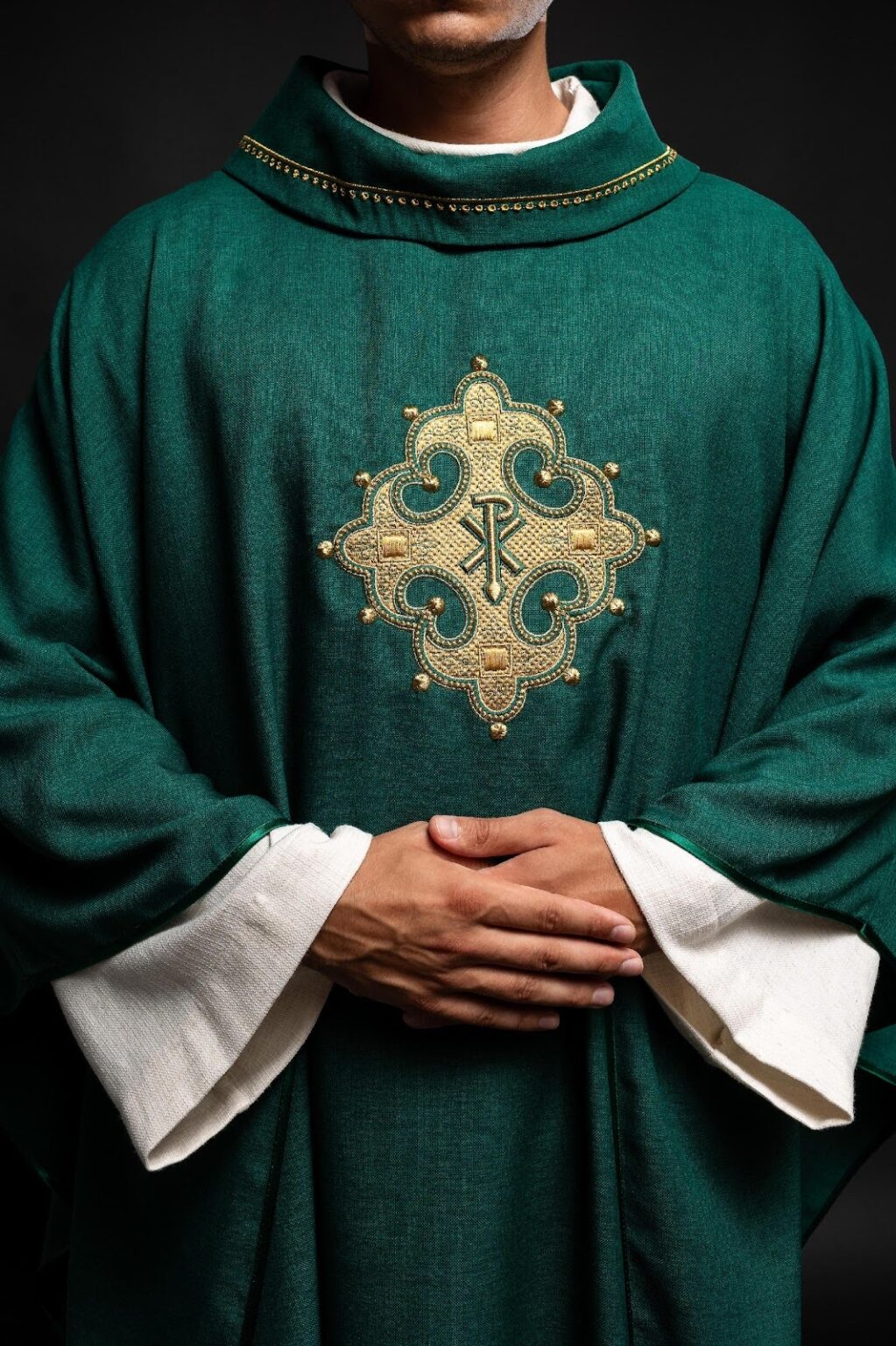Liturgical vestments, an integral part of the celebration of sacraments and church ceremonies, require special care and attention. Their appearance and cleanliness not only affect aesthetics but also reflect due respect for sacred rites. At HAFTINAUSA, as an experienced manufacturer of chasubles and liturgical accessories, we understand the importance of proper care for these exceptional items. Therefore, in this article, we will share our expert knowledge to help clergy and those responsible for maintaining liturgical vestments in perfect condition.
Table of Contents
ToggleWhy is Caring for Liturgical Vestments So Important?
Caring for liturgical vestments goes beyond simply taking care of clothing. It is an act of respect for tradition, symbolism, and the spiritual significance of these objects. Liturgical vestments reflect the dignity of the priestly ministry and emphasize the solemn nature of the liturgy.
- Expression of Respect: Maintaining liturgical vestments in a clean and good condition is an expression of respect for God and the community of believers.
- Durability and Aesthetics: Proper care extends the life of the vestments, preserving their beautiful appearance for years to come.
- Symbolic Meaning: Liturgical vestments are carriers of symbolism, and their cleanliness and tidiness emphasize the spiritual significance of the rites.
Materials and Their Properties: The Key to Proper Care
Different materials require different care methods. Understanding the properties of the fabrics from which liturgical vestments are made is crucial for preserving their beauty and durability.
- Cotton: A natural, breathable, and easy-care material. Can be machine-washed, but prone to shrinkage.
- Linen: A durable and breathable natural material. More difficult to iron than cotton, but less prone to shrinkage.
- Wool: A warm and elegant natural material. Requires gentle washing or dry cleaning.
- Silk: A luxurious and delicate natural material. Should be hand-washed or dry-cleaned, avoid strong sunlight.
- Synthetic fabrics (polyester, viscose): Durable and easy to care for. Do not shrink or wrinkle, but can generate static electricity.
Methods of Cleaning Liturgical Vestments: Hand Washing, Machine Washing, or Dry Cleaning?
The choice of the appropriate cleaning method depends on the type of material, decorations, and the degree of soiling.
- Hand washing: The safest method for delicate materials and vestments with embroidery. Use lukewarm water and a mild detergent. Do not wring, just gently squeeze out the water.
- Machine washing: Acceptable for cotton and linen, but only on a delicate cycle and at a low temperature. Avoid spinning.
- Dry cleaning: The best solution for wool, silk, and vestments with rich decorations. Choose a dry cleaner specializing in liturgical clothing.
Hand Washing Step by Step:
- Fill a bowl with lukewarm water and add a mild detergent.
- Gently submerge the vestment in the water and knead to remove dirt.
- Rinse the vestment in clean water until all detergent is removed.
- Gently squeeze out the water (do not wring!) and spread the vestment on a towel to dry.
Stain Removal: Quick Reaction is Key
Stains on liturgical vestments happen frequently. It is important to act quickly and effectively to avoid permanent stains.
- Types of stains:
- Wax: Scrape off excess wax, then place a paper towel and iron over it.
- Wine: Sprinkle the stain with salt or flour to absorb the wine. Then gently rinse with water.
- Blood: Soak the stain in cold water with salt. Then wash gently.
- Oil: Sprinkle the stain with talcum powder or cornstarch to absorb the grease. Then wash gently.
- What to avoid:
- Using harsh detergents and bleaches.
- Scrubbing stains.
- Drying a stained vestment in a tumble dryer.
Drying and Ironing: Delicacy and Caution
Proper drying and ironing are crucial for maintaining the shape and appearance of liturgical vestments.
- Drying: Dry liturgical vestments flat, in the shade, to avoid fading colors. Avoid tumble drying.
- Ironing: Iron liturgical vestments inside out, using a low temperature and steam. Use a cotton cloth to protect the material from direct contact with the iron.
- Embroidery and decorations: Iron embroidery and decorations on a soft pad to avoid damage.
Storing Liturgical Vestments: Protection Against Dust, Moths, and Moisture
Proper storage of liturgical vestments is an investment in their future.
- Ideal conditions: A dry, airy, and shaded place.
- Covers and hangers: Use special covers for liturgical vestments to protect them from dust and moths. Choose hangers suitable for the type of fabric and cut of the vestment.
- Protection against moths and moisture: Use natural moth repellents such as lavender or cedar. Place moisture absorbers in the closet.
Care of Special Elements: Embroidery, Gold Threads, and Appliqués
Liturgical vestments are often decorated with embroidery, gold threads, and appliqués, which require special care.
- Computer embroidery: Wash by hand or dry clean, avoid scrubbing, and iron inside out.
- Gold and silver threads: Clean with a soft, dry cloth. For heavy soiling, use special preparations for cleaning precious metals.
- Appliqués and decorations: Protect from mechanical damage and avoid contact with sharp objects.
Repairing Damage: When to Do It Yourself and When to Contact a Professional?
Minor damage, such as fraying seams, can be repaired yourself. In case of more serious damage, we recommend using the services of a tailor specializing in liturgical clothing.
- Minor repairs: Sew fraying seams, sew on loose buttons or beads.
- Professional help: Take the vestment for repair when the fabric, embroidery, or decorations are damaged.
- Renovation: Consider renovating a liturgical vestment if it is very old and damaged.
Additional Tips: Prevention Is Better Than Cure
- Avoid damage: Be careful with liturgical vestments during use. Avoid contact with sharp objects and substances that may cause stains.
- Regular inspections: Regularly check the condition of liturgical vestments and remove minor dirt.
- Consultations with an expert: If in doubt, consult an expert in the care of liturgical vestments.
Summary: Caring for Liturgical Vestments – An Expression of Respect and Tradition
Caring for liturgical vestments is not only a duty but also an expression of respect for tradition and faith. Remember that proper care extends the life of the vestments and allows you to maintain their beautiful appearance for years to come: https://haftinausa.com









